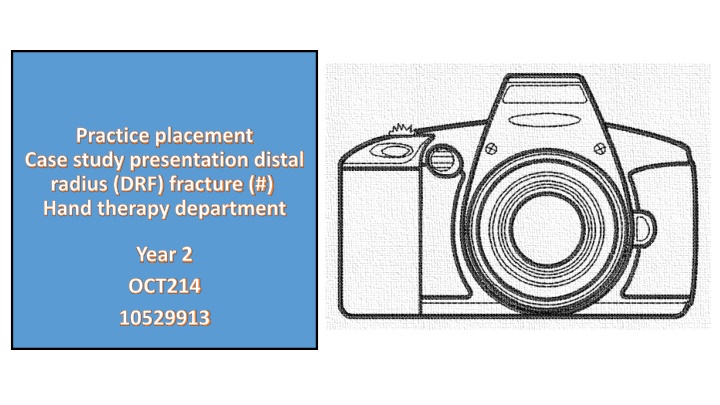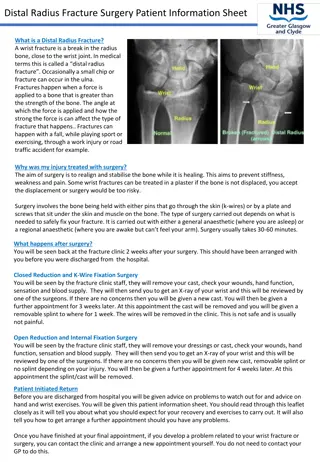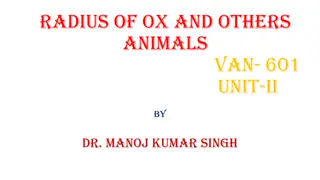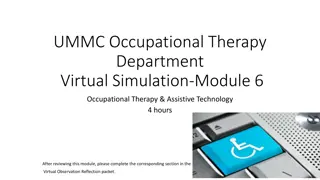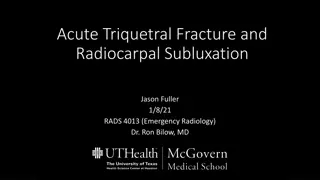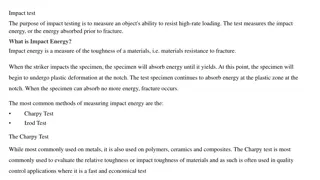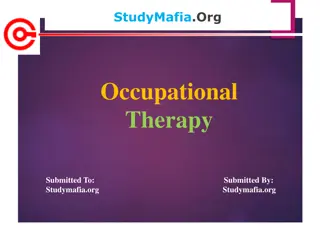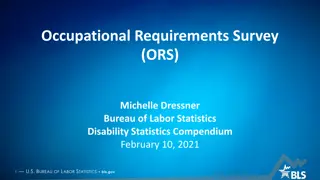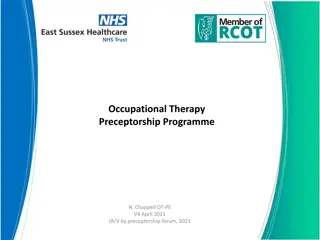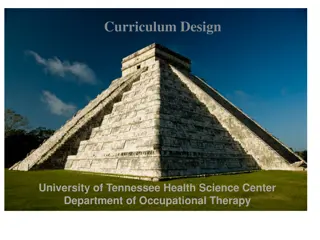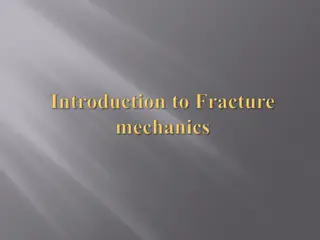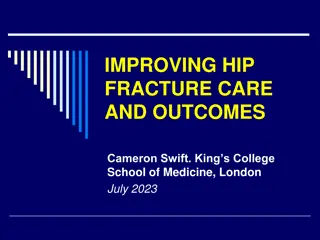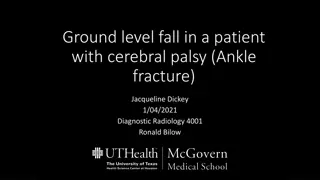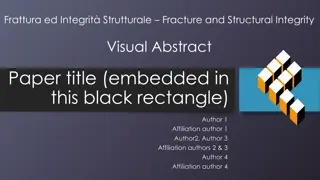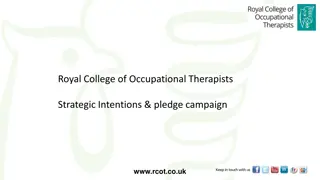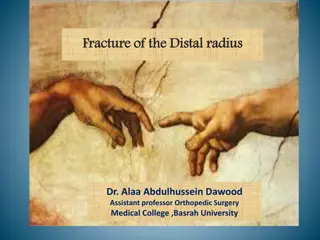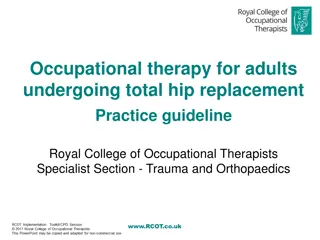Occupational Therapy Management of Distal Radius Fracture in Hand Therapy Department
Occupational therapists play a crucial role in the non-surgical management of hand disorders and physical injuries, such as distal radius fractures. They focus on restoring hand function, motivating patients to exercise independently, providing holistic support, and facilitating scar management. Using the Canadian Model of Occupational Therapy, therapists work towards returning patients to meaningful participation in daily activities, addressing emotional and psychological needs, and aiding in the rehabilitation process. Distal radius fractures are common, with various classifications and treatment options available to improve outcomes and reduce the risk of further complications.
Download Presentation

Please find below an Image/Link to download the presentation.
The content on the website is provided AS IS for your information and personal use only. It may not be sold, licensed, or shared on other websites without obtaining consent from the author.If you encounter any issues during the download, it is possible that the publisher has removed the file from their server.
You are allowed to download the files provided on this website for personal or commercial use, subject to the condition that they are used lawfully. All files are the property of their respective owners.
The content on the website is provided AS IS for your information and personal use only. It may not be sold, licensed, or shared on other websites without obtaining consent from the author.
E N D
Presentation Transcript
Practice placement Case study presentation distal radius (DRF) fracture (#) Hand therapy department Year 2 OCT214 10529913
Placement setting/Role of the Occupational therapist Hand therapy non surgical management of hand disorders & physical injuries using physical methods. Motivate patient to independently exercise/ restoration of hand function. Work with MDT. Use of the Occupational therapy process [1]. Scar management. Advice on ADLs, assist with emotional/ psychological Holistic, client centered practice [2][3]. [4] support. Return patient to meaningful participation their daily activities. Patient appointments, clinics, group therapy sessions. Various referrals. [1] (Creek, 2003), [2] (Parker, 2011), [3] (IFSHT, 2010), [4] (Islandhandtherapy.com, 2017).
Canadian Model of Occupational Therapy and Engagement Person 'Betty [1][2] Spiritual 59 year old woman, divorced, admin/photographer Affective unable to type at work, not able to drive, cannot participate in photography, low confidence, mildly anxious Physical right DRF (Colles #), stiffness in IF, MCP & radial/ulnar joint, reduced function of the wrist (limited AROM), ?Osteopenic. Occupation Occupational therapy process Self-care - showering, cooking Information gathering 'Betty' Productivity admin assistant Leisure - photography Environment Cultural - Western culture Is important in a physical setting to be aware of the psychological impact of a hand injury [2]. The model allowed me to keep this focus in my assessment and treatment and to give a client centered approach [1]. Social - Roles; employed, friend, patient. - Forms; cooking, housework, photographer. Institutional - needing to return to work asap/not take anymore time off Physical difficulty using computer at work and operating her SLR camera. [1] (Polatajiko, Townsend and Craik, 2007), [2] (BAHT, 2013)
Incidence and prevalence DRF are one of the most common types of fractures [1]. DRF of the upper extremities are relatively common accounting for approximately 17% of all fractures in patients visiting A & E [2]. Adults who suffer DRF are at increased risk of further osteoporosis related fractures and represent a high-risk group in whom therapies are available to reduce the risk [3]. Over 20 types of fracture classification of the distal radius [4]. Epidemiology DRF Causes [4] Low-energy [7] [7] High energy [7] Signs and symptoms [4] [5] A broken wrist usually causes immediate pain, tenderness, bruising, and swelling. Deformed/change of sensation in the wrist (secondary to nerve compression). Treatment [4] Non-surgical/surgical Followed by rehabilitation/therapy input Impact of condition on occupational engagement Reduced ROM and strength, limiting performance. Although immobilization can facilitate healing it can affect tendon gliding ability and tenacity after just two weeks [4]. [7] There is a significant correlation between grip function and feeling of capability, confidence and usefulness affecting occupational performance through different stage of recovery. This highlights the importance of having a bio-psychosocial approach in practice [6]. [1] (Nellans, Kowalski, and Chung, 2012), [2] (Jung et al., 2016), [3] (Thompson, Taylor, and Dawson, 2004), [4] (Hove, Lindau, and Holmer, 2014), [5] (Skirven, Osterman, and Fedorczyk, 2011), [6] (Porter, 2013) [7] (Orthoinfo.aaos.org, 2016) [7] Early control of swelling and pain, as well as, early active motion, is of paramount importance in eliminating and preventing dysfunction [4].
Governing body/Policies, guidelines and legislations Relevance to case study/impact on practice College of Occupational Therapists (COT) Code of ethics and professional conduct [1]. Service provision, patient welfare, professionalism, ethical framework within which HCPC registrants must work Healthcare Professional's Council (HCPC) Standards of conduct, performance and ethics [2]. Policies and Legislations In woman aged 45-65 years a Colles fracture, is commonly the first visible manifestation of osteoporosis [4]. Healthcare professionals have responsibility in identifying patients with fall related fractures and low bone mineral density so preventative measures can be taken [5] [6]. National Policy Drivers Osteoporosis guidelines [3] National Institute for Care Excellence (NICE) Osteoarthritis guidelines [7]. Patient education; secondary osteoarthritis typically develops after a DRF [6]. Medicines and Healthcare products Regulatory Agency (MHRA) Custom made medical devices [8]. To consider guidelines for compliance requirements for custom-made medical devices and patient safety. Need to consider as Betty will need a splint/support. Guidelines for best practice, measuring ROM, hand therapy input. British Association of Hand Therapists (BAHT) Hand therapy audit guidelines for clinical practice[9]. Confidentiality, sharing of information, gaining consent. Local Policy Drivers Consent for Examination or Treatment Policy[10]. Guidance for safe practice in preventing the spread of disease or illness within the outpatient department and in community. Infection Control [11]. [1] (COT, 2015a), [2] (HCPC, 2016), [3] (NICE, 2015), [4] (Compston and Rosen, 2009), [5] (Padegimas and Osei, 2013), [6] (Hove, Lindau, and Holmer, 2014), [7] (NICE, 2014), [8] (MHRA, 2013), [9] (BAHT, 2013), [10] (XXX, 2015), [11] (XXX, 2016), [12] (McSherry and Pearce, 2011)
Clinical assessments: Goniometry used to measure the total amount of available motion at a specific joint. Goniometry can be used to measure both active and passive range of motion [1]. Goniometer enables the therapist to record AROM for a patient, enabling patient progress to be monitored. Outcome and outcome measures [9] Dynamometer A quantitative and objective measure of isometric muscular strength of the hand and forearm, enables measureable outcomes to be recorded through assessments [2]. [10] Functional assessments: Patient reported outcome measures (PROMs)[3] - result in a renewed focus on client centred care and holistic evaluation [4]. QDASH self-report questionnaire designed to measure physical function and symptoms in patients with any or several musculoskeletal disorders of the upper limb [5]. It has the ability to detect clinically meaningful change in status, an outcome measure with longitude validity [6]. [11] Oxford Pain scoring to assess function and pain [7]. [12] [1] (Dutton, 2012), [2] (Skirven, Osterman, and Fedorczyk, 2011), [3] (COT, 2010), [4] (Cooper, 2013), [5] (Kennedy et al., 2011), [6] (Whalley and Adams, 2009), [7] (Brook, Connell and Pickering, 2011), [8] (Porter, 2013), [9] (Anon, 2016), [10] (Topendsports.com, 2016), [11] (Measure and Health, 2016), [12] (Amazon.com, 2016), [13] (COT, 2015b). The results highlight the importance of using a combination of functional assessment and questionnaires in order to address complexity, acquiring a more complete picture of limitations following a DRF [8].
Assessment Findings Biomechanical frame of reference [1] Initial appointment (6 weeks post #) - Skin right hand darker shade red slightly warmer than left - Right more swollen than Left - Radial border, bruised along ulna mid shaft. Left thumb base sore - Pins and Needles along ulnar into hand, muted sensation into finger tips like feeling plastic *Stiffness in RD/UD, limited AROM, ? Reduced tendon glide as not able to flex fingers in the cast limited flex/ext of wrist * Assessment and frames of reference Pain Sensory Oedema Movement (Active/Passive) Skin Temperature Occupational therapy process 2nd appointment/review (7 weeks post #) Swelling reduced, still muted sensation in all finger tips and distal tip of thumb, bruising significantly reduced, reduced pain, AROM measurements and grip strength recorded 3rd appointment/review (9 weeks post #) Minimal swelling, still limited AROM possibly due to non compliance of completing home exercises. Still significant pain on movement possibly due to reduced tendon glide opposed to joint stiffness. Hand class (10 weeks post #) Attended hand class to focus on improve greater range of movement. [1] (Supyk-Mellson and McKenna, 2010).
Long term aim To be able to functionally use SLR camera and return to photography group. SMART Aims and objectives Long term objective Attend hand class to achieve maximum potential range of movement alongside a home exercise program > 12 months. Short term aim To be able to use right hand to type at work. Short Term Objectives (> 2 months) To complete regular hand exercises to improve range of movement (4 weeks). To reduce swelling in the hand limiting range movement (4 weeks). To reduce pain to improve ability to complete exercise and improve range (4 weeks) . OT process influenced by patient aim [1] (Parker, 2011).
Intervention, approaches and implementation Appointments sessions Intervention Clinical Reasoning / linking into what aim Initial appointment Retrograde massage - until swelling has dissipated. Technopro splint issued - advised to wear as frequently as possible. Safe use of splint discussed [1]. Exercises for wrist and fingers - demonstrated and practiced - advised to complete hourly Linking to short term aims:- Reduced swelling - need ensure swelling is reduced quickly to encourage wrist movement. An important preventative and rehabilitative strategy [2] [3]. To support joint and rehabilitation and pain management, occupational therapists prescribe orthoses to facilitate attainment of occupational outcomes [2]. 2nd appointment/review Advised to continue with exercises to encourage increased ROM, to continue to wear splint, pain management, discussed option of attending hand class, to review in 1 week. 3rd appointment/review Heavily advised to continue with exercises and pain management. To consider attending hand class agreed to start in 1 week. Each intervention used addresses the affective and physical aspects of the Canadian Model of Occupational Therapy and Engagement (CMOP-e) model that has been used to guide the OT process as although its remedial based the interventions are linked to occupation and reengagement with function and occupation, enhancing mood. [1] (MHRA, 2013), [2] (Lannin and Novak, 2010), [3] (Hove, Lindau, and Holmer, 2014), [4] (Curtin, 2010).
Bettys Hand Class Programme Contextualisation into everyday activities. Warm up Water and ball 10 minutes to warm hand up. Powerweb Colour graded webs for flexion and extension, finger strength and dexterity exercises. Finger dexterity and power needed for typing and pressing camera buttons. Span game To encourage pronation/supination. Required for holding and positioning camera. CPM (continuous passive movement) Machine Controlled flex./ext. and pro./sup. Required to get camera out of case. Table top exercises Moving paper/cloth etc. in radial and ulnar deviation. Required for taking lens off/refocusing camera. Intervention links to aspects of the model as it address both the physical and psychosocial aspects. [4] Although the therapist sets the hand therapy programme, client centred approach as patient can chose which exercises to do/lead their own rehabilitation Group intervention Hand class Occupational therapy process Patient asked to complete QDASH outcome measure at beginning and end of attendance evaluates the patient experience and assessment of their perceived functional ability [1]. Specific exercises focused around enabling patient to achieve her aims and objectives of increased range of movement and function in order to be able to reengage with chosen occupations. Patient not only had significant improvement with her ROM but the group changed her attitude towards her injury and recovery, appeared to be less anxious and became compliant with her home exercises. All leading to improved outcomes [2]. [3] [1] (Whalley and Adams, 2009), [2] (Bamford and Walker, 2010), [3] (Exerciser , 2016), [4] (Kokaspeles.lv, 2017). .
Pre-intervention End of intervention Right hand Goniometry Wrist Flex/Ext RD/UD Pro/Sup Right hand Goniometry Wrist Flex/Ext Occupational therapy process Outcomes of interventions 26/16 6/16 90/20 36/24 Fingers IF MF RF LF Fingers IF MF RF LF MCP 0/64 0/76 0/66 0/54 MCP 0/65 0/70 0/62 0/50 PIP 0/90 0/90 0/90 0/72 PIP 0/97 0/95 0/90 0/70 DIP 0/33 0/45 0/40 25/55 DIP 0/50 0/54 0/52 0/60 Dynamometer Right flicker Dynamometer Right - 2kg Left 14kg Left 20kg Functional assessment:- Functional assessment:- QDASH 63.63 QDASH 35 Everything takes longer Oxford Pain scoring - 5/10 OxfordPain scoring - 7/10
At this current time the case study therapeutic input still continues. The patient will be regularly reviewed to determine how long she needs to attend hand class. Following a distal radius # rehabilitation can take 6-12 months to optimise outcomes [1] [2]. End of intervention End of intervention, discharge Occupational therapy process Highlight further implications associated with/after obtaining a DRF to patient prevention of falling is better than cure [1]. NICE guidelines for Osteoporosis [3] If the fracture is thought to be a fragility fracture, guidelines recommend FRAX [4] the WHO fracture risk assessment tool predicts an individual s risk of fracture, providing general clinical guidance for treatment decisions. Secondary osteoarthritis typically develops after a DRF, follow NICE guidelines for diagnosis of Osteoarthritis [5] and treat/advise accordingly. Patient safety advice/education on discharge/risk factors [1] (Hove, Lindau, and Holmer, 2014), [2] Porter, 2013), [3] ] (NICE, 2015), [4] (Kanis et al., 2008), [5] ] (NICE, 2014).
Was I client centred? Led by patient Took into consideration patient s wants and needs when considering intervention and desired outcomes. Why did use CMOP-e? Enables positive collaborative approach [1] [2]. Focuses on occupational performance, need and engagement [1] [2]. CMOP-E arguably emphasizes the importance of the person more than PEOP model [3]. Although may not be suitable for clients with cognitive dysfunction [1]. Occupational therapy process Why did I pick the case study? Patient and injury/occupational disruption typical to placement setting. If there anything you would have done or could have done differently to improve patient outcomes? Asked patient to complete home exercises sheet to monitor frequency of completion Betty clearly said she had not been completing exercises at home. Case study review [1] (Clarke, 2003), [2] (Fawcett, 2007), [3] (Wong and Fisher, 2015).
Strengths Weaknesses Develop my communication/ interpersonal skills with professionals and patients. Develop understanding of OT/ MDT role, utilise experience in acute setting. Thoroughly enjoyed every aspect of placement, inspired by the professionals have been working alongside considering a career in hand therapy. Heavily anatomy, physiology and pathology based, lots to learn and information to retain. Service Evaluation of placement Work under pressure Lack or resources/materials has an impact on practice and delivery of service. Service Collaborative team. Effective MDT working. Deliver excellent patient centred care. Opportunities Threats Opportunity to develop focused learning in a specialised area of occupational therapy. Experience new assessments/ interventions. To develop on existing clinical reasoning. Funding cuts? Potential service reorganisation? Service Critique of information systems busy service, could paperless system speed up non clinical time? Personal reflection on placement. Could hand class/group therapy interventions encourage more effective time management within the service? Reduce patient pending lists? Treating people collectively?
Amazon.com. (2016). Oxford Handbook of Pain Management (Oxford Medical Handbooks): 9780199298143: Medicine & Health Science Books @ Amazon.com. [online] Available at: https://www.amazon.com/Oxford-Handbook-Management-Medical- Handbooks/dp/0199298149 (Accessed 11 December 2016). Anon, (2016). [online] Available at: https://www.researchgate.net/figure/233737120_fig4_Fig-4-Wrist-extension-and-flexion- ROM-measured-with-goniometer-from-ulnar-side (Accessed 11 December 2016). Bamford, R. and Walker, D. (2010). A qualitative investigation into the rehabilitation experience of patients following wrist fracture , Hand Therapy, 15(3), pp. 54 61. doi: 10.1258/ht.2010.010013. British Association of Hand Therapy (BAHT) (2013). Hand therapy audit guidelines for clinical practice. [Online] Available at: http://www.hand-therapy.co.uk/ (Accessed 10 December 2016). References Brook, P., Connell, J. and Pickering, T. (2011). Oxford handbook of pain management. Oxford ; New York, NY : Oxford University Press. Clarke, C. (2003). Clinical Application of the Canadian Model of Occupational Performance in a Forensic Rehabilitation Hostel . The British Journal of Occupational Therapy, 66(4), pp. 171-174. doi: 10.1177/030802260306600407. College of Occupational Therapists [COT], (2010). The importance of outcome measures. [Online] Available at: http://www.slideshare.net/baotcot/the-importance-ofmeasuringoutcomes (Accessed 4 December 2016). College of Occupational Therapists (COT) (2011). Professional standards for occupational therapy [Online] Available at: https://www.cot.co.uk/standards-ethics/capability-competence-and-lifelong-learning (Accessed 25 November 2016). College of Occupational Therapists (COT) (2015a). Code of ethics and professional conduct. London: COT. College of Occupational Therapists (COT) (2015b). Measuring Outcomes [Online] Available at: file:///C:/Users/cdone/Downloads/Research-Briefing-Measuring-Outcomes-Nov2015.pdf (Accessed 25 November 2016). Compston, J. E. and Rosen, C. J. (2009). Fast facts: Osteoporosis (6th Edn.) United Kingdom: Health Press. Cooper, C. (2013). Fundamentals of hand therapy: Clinical reasoning and treatment guidelines for common diagnoses of the upper extremity. 2nd edn. Philadelphia, PA, United States: Mosby.
Creek, J. (2003). Occupational therapy defined as a complex intervention. COT: London. [Onlne]. At https://www.cot.co.uk/publication/publications/occupational-therapy-defined-complex-intervention (Accessed 4 January 2017). Curtin, M, (2010). Enabling skills and strategies in: Curtin, M. (Ed.), Molineux, M. (Ed.), Supyk-Mellson, J. (Ed.) Occupational Therapy and Physical Dysfunction Enabling Occupational Therapy (6th Edn.) Edinburgh: ChurchillLivingstone/Elsevier. pp. 111-125. Dutton, M. (2012). Dutton s Orthopaedic examination evaluation and intervention (3rd edn.) New York: McGraw Hill Medical. Exerciser , F. (2016). Finger Fitness Power Web Jr. Hand Exerciser. [online] Musician's Friend. Available at: http://www.musiciansfriend.com/accessories/finger-fitness-power-web-jr.-hand-exerciser (Accessed 11 Dec. 2016). Fawcett, A. (2007). Principles of assessment and outcome measurement for occupational therapists and physiotherapists. Chichester, England: John Wiley & Sons. References Handoll, H. and Elliot, J. (2015). Rehabilitation for distal radial fractures in adults [Online] Available at: http://onlinelibrary.wiley.com/doi/10.1002/14651858.CD003324.pub3/full (Accessed 4 December 2016). Healthcare Professionals Council (HCPC) (2016). Standards of conduct, performance and ethics [Online] Available at: http://www.hcpc- uk.org/publications/standards/index.asp?id=38 (Accessed 4 December 2016). Hove, L.M., Lindau, T. and Holmer, P. (eds.) (2014). Distal radius fractures: Current concepts. Germany: Springer-Verlag Berlin and Heidelberg GmbH & Co. K. International Federation of Societies for Hand Therapy (IFSHT) (2010). IFSHT Hand therapy practice profile [Online] Available at: http://www.hand- therapy.co.uk/index.php?option=com_content&view=article&id=123&Itemid=104 (Accessed 5 January 2017). Islandhandtherapy.com. (2017). Island Hand Therapy Clinic: Hand Therapy, Occupational Therapy and Physiotherapy in Victoria British Columbia. [online] Available at: http://www.islandhandtherapy.com/ [Accessed 6 Jan. 2017]. Jung, H.J., Park, H.Y., Kim, J.S., Yoon, J.-O. and Jeon, I.-H. (2016). Bone mineral density and prevalence of osteoporosis in Postmenopausal Korean women with low-energy distal radius fractures , Journal of Korean Medical Science, 31(6), p. 972. doi: 10.3346/jkms.2016.31.6.972. Kanis, J., Johnell, O., Oden, A., Johansson, H. and McCloskey, E. (2008). FRAX and the assessment of fracture probability in men and women from the UK. Osteoporosis International, 19(4), pp.385-397. Kennedy, C. A., Beaton, D. E., Solway, S., McConnell, S., and Bombardier, C. (2011). The DASH outcome measure user s manual. (3rd ed.) Toronto: Institute for Work & Health.
Kokaspeles.lv. (2017). Handmade Wooden Toys: The tower of Hanoi. [online] Available at: http://kokaspeles.lv/en/categories/logics/the-tower-of-hanoi (Accessed 4 January 2017). Lannin, N. and Novak, I. (2010). Orthotics for occupational outcomes in: Curtin, M. (Ed.), Molineux, M. (Ed.), Supyk-Mellson, J. (Ed.) Occupational Therapy and Physical Dysfunction Enabling Occupational Therapy (6th Edn.) Edinburgh: ChurchillLivingstone/Elsevier. pp. 507-526. McSherry, R. and Pearce, P. (2011). Clinical Governance. 1st ed. Hoboken: John Wiley & Sons. Measure, D. and Health, I. (2016). DASH Outcome Measure on the App Store. [online] App Store. Available at: https://itunes.apple.com/us/app/dash-outcome-measure/id656696682?mt=8 (Accessed 11 December 2016). References Medicines and Healthcare products Regulatory Agency (MHRA) (2013). Custom made medical devices [Online] Available at: https://www.gov.uk/government/publications/custom-made-medical-devices (Accessed 4 December 2016). National Institution of Care Excellence (NICE) (2014). Osteoarthritis: Care and management [Online] Available at: https://www.nice.org.uk/guidance/cg177/chapter/1-recommendations (Accessed 4 December 2016). National Institution of Care Excellence (NICE) (2015). Osteoporosis: assessing the risk of fragility fracture [Online] Available at: https://www.nice.org.uk/researchrecommendation/frax-and-qfracture-in-adults-with-secondary-causes-of-osteoporosis-what-is- the-utility-of-frax-and-qfracture-in-detecting-risk-of-fragility-fracture-in-adults-with-secondary-causes-of-osteoporosis (Accessed 4 December 2016). Nellans, K.W., Kowalski, E. and Chung, K.C. (2012). The Epidemiology of distal radius fractures , Hand Clinics, 28(2), pp. 113 125. doi: 10.1016/j.hcl.2012.02.001. Orthoinfo.aaos.org. (2016). Distal Radius Fractures (Broken Wrist)-OrthoInfo - AAOS. [online] Available at: http://orthoinfo.aaos.org/topic.cfm?topic=a00412 (Accessed 11 Dec. 2016). Padegimas, E.M. and Osei, D.A. (2013). Evaluation and treatment of osetoporotic distal radius fracture in the elderly patient , Current Reviews in Musculoskeletal Medicine, 6(1), pp. 41 46. doi: 10.1007/s12178-012-9153-8.
Parker, D. M. (2011). The client centred frame of reference in Duncan, E.A.S., (ed.) Foundations for practice in occupational therapy. Bookshelf [Online]. Available at: https://bookshelf.vitalsource.com/#/books/9780702046612/cfi/6/6[;vnd.vst.idref=B978-0-7020-3232- 5.00026-8]!/4/2[B978-0-7020-3232-5.00026-8] (Accessed 4 December 2016). Polatajiko, H. J., Townsend, E. A. and Craik, J. (2007). Canadian Model of Occupational Performance and Engagement (CMOP-E) in Townsend, E. A. and Polatajiko, H. J. (Eds.) Enabling occupation II: Advancing and occupational therapy vision of health, wellbeing & justice through occupation. Ottawa, ON: CAOT Publications ACE. Pp. 22-36. Porter, S. (2013). Occupational performance and grip function following distal radius fracture: A longitudinal study over a six-month period , Hand Therapy, 18(4), pp. 118 128. doi: 10.1177/1758998313512280. Skirven, T.M., Osterman, L.A. and Fedorczyk, J. (2011). Rehabilitation of the hand and upper extremity, 2-Volume set: Expert consult: Online and print. 6th edn. Philadelphia, PA: Elsevier Science Health Science div. References Supyk-Mellson, J. and McKenna, J. (2010). Understanding models of practice in: Curtin, M. (Ed.), Molineux, M. (Ed.), Supyk-Mellson, J. (Ed.) Occupational Therapy and Physical Dysfunction Enabling Occupational Therapy (6th Edn.) Edinburgh: ChurchillLivingstone/Elsevier. pp. 67-79. Thompson, P.W., Taylor, J. and Dawson, A. (2004). The annual incidence and seasonal variation of fractures of the distal radius in men and women over 25 years in Dorset, UK , Injury, 35(5), pp. 462 466. doi: 10.1016/s0020-1383(03)00117-7. Topendsports.com. (2016). About Handgrip Dynamometers. [online] Available at: http://www.topendsports.com/testing/products/grip- dynamometer/ (Accessed 11 Dec. 2016). Whalley, K. and Adams, J. (2009). The longitudinal validity of the quick and full version of the disability of the arm shoulder and hand questionnaire in musculoskeletal hand outpatients , Hand Therapy, 14(1), pp. 22 25. doi: 10.1258/ht.2009.009003. Wong, S. and Fisher, G. (2015). Comparing and Using Occupation-Focused Models. Occupational Therapy In Health Care, 29(3), pp.297-315. XXX (2015). Infection Prevention & Control Policy. [Online] Available at: https://xxxxxxxxxxxxxx/a-z/infection-control/infection-control- documents/?opentab=1 (Accessed 10 December 2016). XXX (2016). Consent for Examination or Treatment Policy. [Online] Available at: https://xxxxxxxxxxxxxx/easysiteweb/getresource.axd?assetid=3077&type=0&servicetype=1 (Accessed 10 December 2016).
Any questions??
